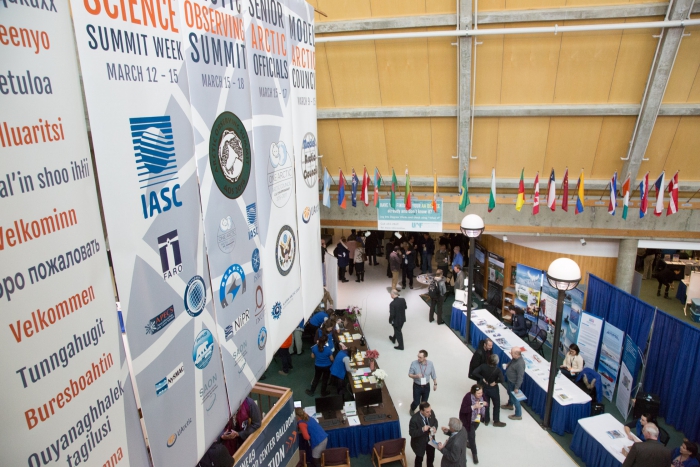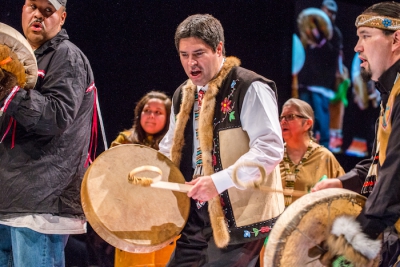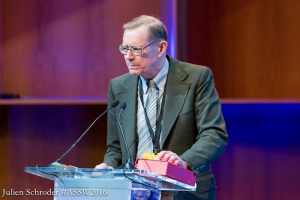By: Kristin Timm, Science Communications Lead, Scenarios Network for Alaska and Arctic Planning, University of Alaska Fairbanks
Over 1,000 Arctic experts and enthusiasts convened in Fairbanks, Alaska on 11-18 March for the 2016 Arctic Science Summit Week, Arctic Observing Summit, and numerous other meetings and events. With participants representing 30 nations and more than 130 different institutions, the gathering represents a significant step towards the future of Arctic research and policy.

While this was the 18th Arctic Science Summit Week (ASSW) convened by the International Arctic Science Committee (IASC) and its partner organizations, the conference achieved many notable firsts. For the first time, the Arctic Council held their Senior Arctic Officials meeting in conjunction with ASSW. It was also the first time that representatives from the U.S. Polar Research Board (U.S. PRB), U.S. Arctic Research Commission (USARC), European Polar Board (EPB), Polar Knowledge Canada (PKC), and the Asian Forum on Polar Sciences (AFOPS) jointly convened. The University of Alaska Fairbanks (UAF) hosted the first International Arctic Assembly in the middle of the week when most of the meeting participants overlapped. Approximately 100 smaller side meetings and sessions complemented these and other major meetings. From Arctic health and community resilience, to data collaboration and science communication, the diversity of meeting subjects covered an impressively range of Arctic issues.
Participants were equally diverse, with roughly a tenth of the conference participants representing Arctic indigenous groups and private industry. An additional 20 percent of participants represented local, state/provincial, or federal governments or agencies. This convergence of scientists, policy makers, technical specialists, security and defense representatives, local residents, and indigenous stakeholders enabled an extensive and genuine exchange of ideas and concerns. The week provided an excellent opportunity for a dialogue to better understand the complex interplay of interests in the Arctic and to translate scientific research into specific plans and actions to respond to rapid Arctic change.
The conference provided an indication of the acute ability of the Arctic community to pull together towards common visions and goals; despite their different scientific disciplines, missions, and nationalities, progress was made on several specific issues, including:

Arctic Science Summit Week
ASSW created opportunities for collaboration and strategic planning on international research projects. With representatives from federal agencies and other governing bodies, this enabled the concerns of many perspectives to be included and ensures communication to all major parties involved.
Arctic Observing Summit
The Arctic Observing Summit resolved to create an observing system that will support decision making in a rapidly changing environment. "Arctic change is a consequence of global change, with global repercussions, and addressing it is a global responsibility," the statement concludes. "It is time to move forward with full intent and full engagement and act on these recommendations of summit participants."
Multidisciplinary Drifting Observatory for the Study of Arctic Climate (MOSAiC)
The MOSAiC session provided an opportunity to unveil the MOSAiC implementation plan, which has been under development with support from the International Arctic Science Committee- Third International Conference on Arctic Research Planning
(IASC-ICARPIII) process. The session updated the community on specific details related to the project design, re-supply considerations, drift trajectory, timing, project leadership/management, and funding considerations. It was very well attended and had great engagement, suggesting a growing excitement in the community.
Third International Conference on Arctic Research Planning

Dr. John Walsh (Chief Scientist at the International Arctic Research Center (IARC), University of Alaska Fairbanks) was awarded the International Arctic Science Committee (IASC) medal during ASSW 2016, and delivered a compelling lecture about his Arctic climate change studies. The medal committee selected Walsh due to his exceptional contributions to modeling and evaluating climate change impacts in the Arctic, particularly with regard to his sustained and distinguished contributions to quantitatively improving our understanding of the Arctic.
The final conference statement from the Third International Conference on Arctic Research Planning (ICARPIII) was released during ASSW 2016. This was released as a plan for integrating Arctic research as a roadmap for the future. Numerous recommendations focused upon understanding the role of the Arctic in the global system. Additional guidance was provided to enhance observations and increase the predictive capability of future climate dynamics and ecosystem responses. Many recommendations were targeted to understanding the vulnerability and resilience of Arctic environments and societies.
Many school children, community members, and press were also engaged in the excitement and energy that surrounded the summit. Over 150 pieces of original art and videos were submitted by students from Alaska and as far away as Russia, Wisconsin, and Arizona. Over 30 public outreach events, field trips, and UAF facility tours were conducted over the course of the week giving Alaskans and the Fairbanks community opportunities to mingle with conference participants and learn about science and policy issues in their Arctic backyard. Social media and live web streaming enabled virtual participation in several parts of the meeting, and 2,000 unique views were documented when people around the world joined the live web-stream. Eight journalism fellows helped carry stories—both specifically from the week and from Arctic science more generally¬—to audiences around the nation and world through articles in numerous news outlets including the Washington Post, the Guardian, and EFE (the largest Spanish-language news service).
Hosting the largest Arctic Science Summit Week to date was no small effort. The Fairbanks community, the Fairbanks Convention and Visitors Bureau, over 200 volunteers, and dozens of sponsors made this event possible. In addition to countless hours and in-kind support by the University of Alaska Fairbanks, the major conference sponsors included:
- NSF
- NASA
- Department of Energy
- NOAA
- North Slope Science Initiative
- Alaska EPSCoR
- U.S. Arctic Research Commission
- Alaska Ocean Observing System
- North Pacific Research Board
If you attended ASSW or AOS, you can help the organizers evaluate the meeting by completing a short post-conference evaluation available here.
Photos, videos, documents, news stories, and more information about the 2016 Arctic Science Summit Week are available on the ASSW 2016 website.
